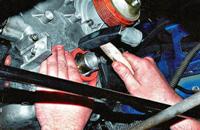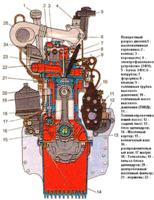Fuel is supplied from a tank installed under the bottom in the area of the rear seat
The fuel tank consists of two stamped steel parts welded together.
The filling pipe is connected to the tank with a petrol-resistant rubber hose
A ventilation tube is welded into the upper part of the filling pipe, connected to the tank with a plastic hose.
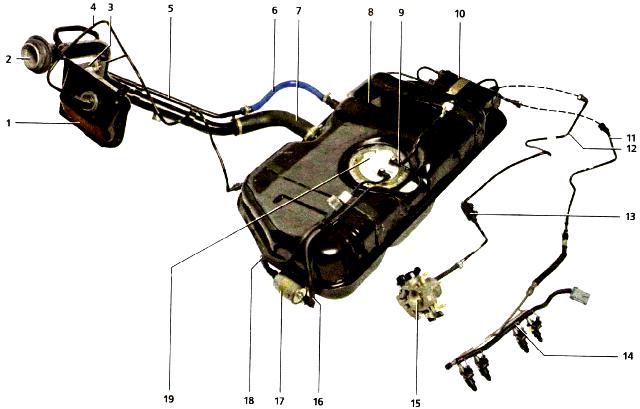
Scheme of the engine power system: 1 - separator; 2 - filling pipe; 3 - hose for supplying fuel vapor from the tank to the separator; 4 - pipe for removing fuel vapors from the separator to the adsorber; 5 - ventilation tube; 6 - ventilation tube hose; 7 - filler pipe hose, 8 - fuel tank, 9 - tee; 10 - adsorber; 11 - fuel supply pipe to the fuel rail; 12 - tube for supplying fuel vapor to the canister purge solenoid valve; 13 - solenoid valve for adsorber purge; 14 - fuel rail with nozzles; 15 - throttle assembly; 16 - fuel supply hose to the tee; 17 - fuel filter; 18 - fuel supply hose to the fuel filter; 19 - fuel module
The vent tube is used to vent air forced out of the tank when refueling.
The fuel tank vent inlet and outlet valves are built into the filler cap.
Fuel module
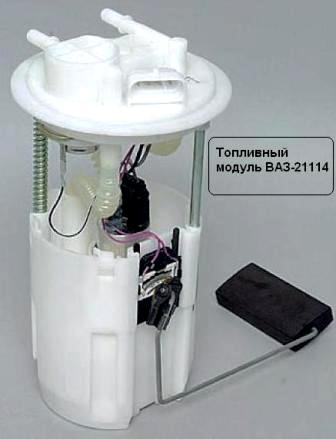
The fuel module, which includes the fuel pump, fuel pressure regulator and fuel gauge sensor, is installed in the fuel tank.
There is a mesh filter at the module inlet for coarse fuel cleaning.
For access to the fuel module, a hatch is made under the rear seat cushion in the bottom of the car.
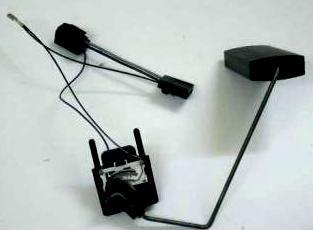
The fuel gauge sensor controls the operation of the dial gauge and signaling device located in the instrument cluster.
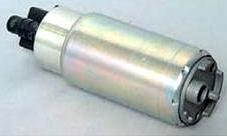
The fuel pump is electrically submersible, rotary.
The fuel pump is turned on by the command of the electronic control unit (controller) when the ignition is turned on through the relay.
The pump creates a pressure in the system that exceeds the operating pressure in the fuel rail.
From the pump, fuel is supplied under pressure to the fuel filter.
Fuel filter
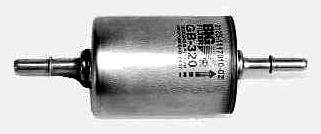
The fine fuel filter is non-separable, with a paper filter element. The filter is attached to the fuel tank bracket, on the right.
An arrow is marked on the filter housing, which must coincide with the direction of fuel flow.
After the filter, a tee is built into the injection fuel line, through which fuel is supplied to the fuel rail and the fuel pressure regulator located in the fuel module.
Fuel pressure regulator

The fuel pressure regulator is a valve that opens when the fuel pressure in the line is exceeded, bleeding some of the fuel into the tank.
The pressure regulator is non-separable, in case of failure it must be replaced.
Fuel pressure in the fuel rail with the ignition on and the engine off should be between 3.6 and 4.0 bar.
Fuel rail
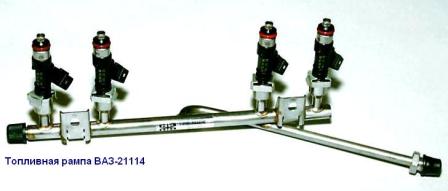
The fuel rail is a pipe with nozzles installed on it. The ramp is attached to the intake pipe with two screws.
Fuel under pressure is supplied to the internal cavity of the ramp, and from there - through the nozzles into the intake pipe.
Injector

The injector is a solenoid valve that allows fuel to pass when voltage is applied to it and locks under the action of a return spring when de-energized.
Atomizer is made at the nozzle outlet, through which fuel is injected into the intake tract.
The controller controls the operation of the injectors. The nozzles are sealed in the rail and inlet pipe with rubber rings and fixed on the rail with metal brackets.
If the winding is broken or shorted, the nozzle must be replaced. If the nozzles are clogged, they can be washed without dismantling at a special stand.
Air filter
Air is supplied to the throttle assembly of the engine through an air intake, an air filter and a corrugated rubber hose.
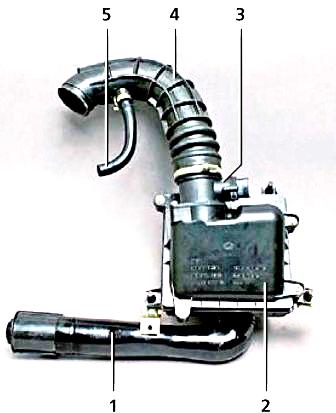
The air filter is installed in the front left of the engine compartment on three rubber holders (supports).
The filter element is paper.
After the filter, the air passes through the mass air flow sensor.
Throttle assembly
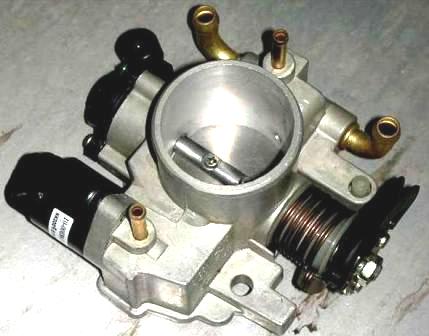
The throttle assembly is a throttle body (with channels made in it), on which the idle air control and throttle position sensor are installed.
The throttle assembly is fixed to the intake pipe.
To prevent freezing of the throttle assembly at low temperatures and high ambient humidity, a heating unit is built into the assembly, through which the cooling system fluid circulates.
When you press the "gas" pedal, the throttle valve opens, changing the amount of air entering the engine (the fuel supply is calculated by the controller depending on the air flow).
Idle speed control
When the engine is idling (throttle closed), the controller controls the air supply using the idle air control (IAC).
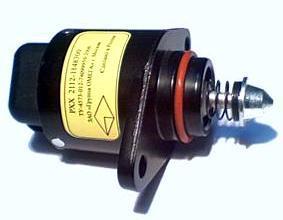
The idle speed controller is a stepper motor that moves the valve.
The shut-off element of the valve (needle) changes the flow area of the channel and provides regulation of the air flow bypassing the throttle valve.
To increase the idle speed, the controller sends a control signal to open the valve, increasing the air supply bypassing the throttle, and, conversely, to reduce the speed, a command is given to close the valve.
In addition to controlling the idle speed of the crankshaft, the controller controls the IAC, reducing the toxicity of exhaust gases:
- when braking by the engine, the throttle closes abruptly.
In this case, the IAC increases the air supply bypassing the throttle, resulting in a leaner fuel mixture.
This helps to reduce hydrocarbon and carbon monoxide emissions.
The idle speed regulator is non-separable and must be replaced in case of failure.
Evaporative Emission System
The fuel vapor recovery system used in the power system includes a separator, an adsorber, an adsorber purge solenoid valve, connecting pipes and hoses.
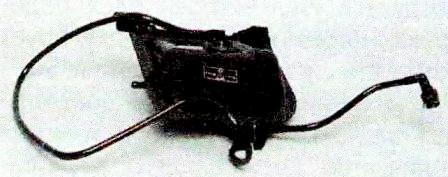
The separator is installed in the right rear wheel arch.
Fuel vapors from the tank are partially condensed in a separator, from which the condensate is drained back into the tank through a hose and a filling pipe.
A gravity valve is installed in the separator, which prevents fuel from leaking out of the tank when the vehicle rolls over.
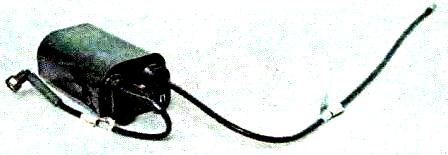
From the separator, fuel vapors enter the adsorber (mounted on the top of the fuel tank, on the left side) through the fitting with the inscription "TANK", where they are absorbed by activated carbon.
The second canister fitting with the inscription "PURGE" is connected through the canister purge solenoid valve to the throttle assembly, and the third one with the inscription "AIR" is connected to the atmosphere.

The canister purge solenoid valve is mounted on a bracket attached to the air filter housing.
When the engine is stopped, the purge solenoid valve is closed, and in this case the adsorber does not communicate with the throttle assembly.
The controller, controlling the solenoid valve, purges the adsorber after the engine has been running for a specified period of time from the moment of switching to the closed-loop fuel supply control mode (the control oxygen sensor must be warmed up to the required temperature).
The valve communicates the cavity of the adsorber with the throttle assembly - and the sorbent is purged: fuel vapors are mixed with air and discharged through the throttle assembly into the intake tract and further into the engine cylinders.
The greater the air consumption of the engine, the longer the duration of the control pulses of the controller and the more intense the purge.







